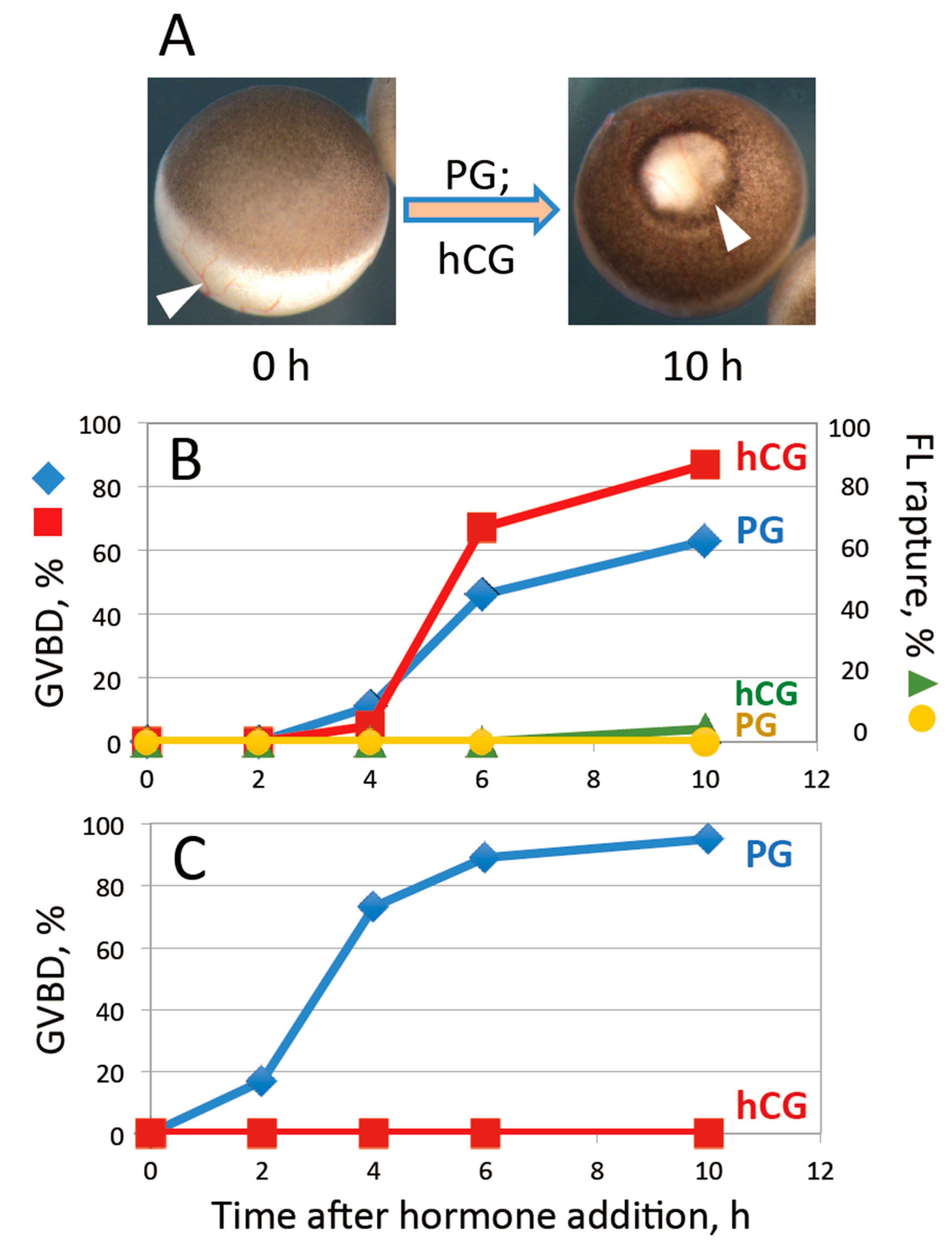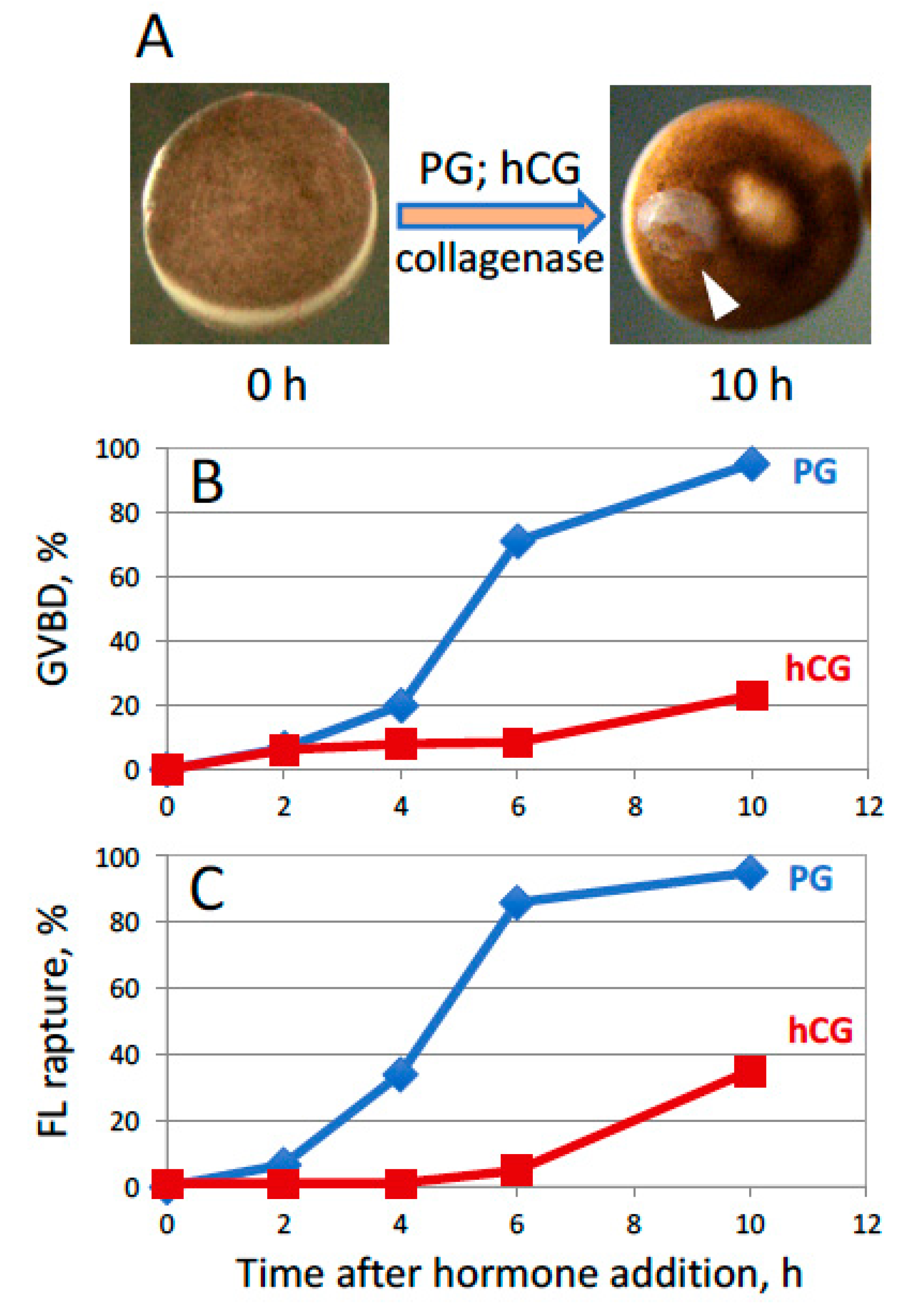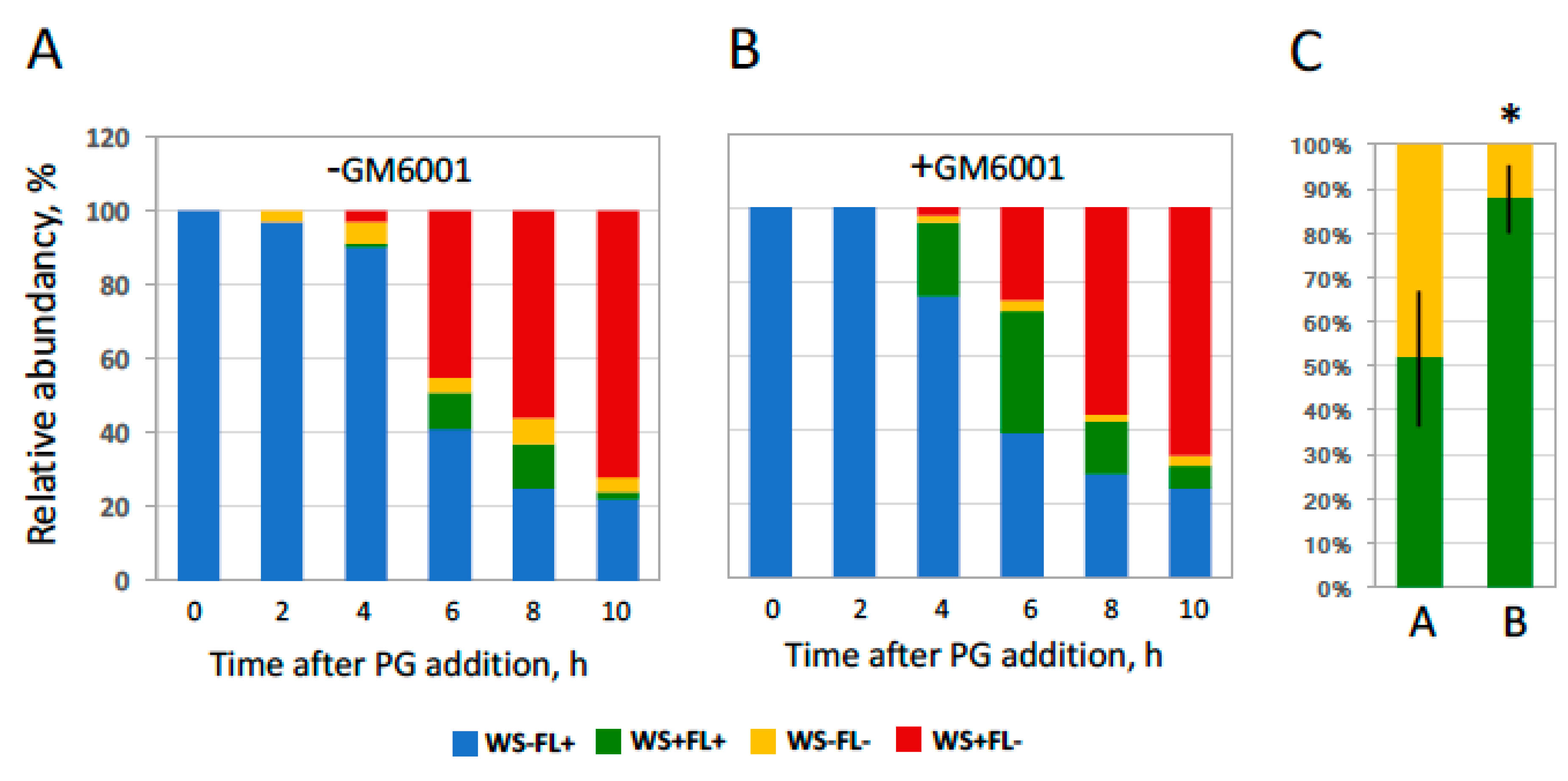In Vitro Reconstruction of Xenopus Oocyte Ovulation
Abstract
1. Introduction
2. Results
2.1. PG and Gonadotropin Induce In Vitro Oocyte Maturation without Follicle Rupture
2.2. Low Concentration of Collagenase in the Incubation Medium Enables Hormone-dependent Follicular Rupture
2.3. Short-term Pretreatment of Follicles with Collagenase Enables Hormone-Dependent Follicular Rupture
2.4. Timing of Maturation and Follicular Rupture During In Vitro Ovulation
2.5. Follicular Rupture Is Delayed in the Presence of an MMP Inhibitor
2.6. Inhibition of the MAPK Pathway Suppresses Both Steroid-Induced Maturation and Follicular Rupture
3. Discussion
4. Materials and Methods
4.1. Materials
4.2. Animals and Cells
4.3. Treatment of Oocytes with Collagenase, MMP, and MEK Inhibitors
4.4. Microscopic Observations and Image Processing
4.5. Immunoblotting
4.6. Other Methods
5. Conclusions
Author Contributions
Funding
Acknowledgments
Conflicts of Interest
Abbreviations
| CBB | Coomassie Brilliant Blue |
| CCD | Charge-coupled device |
| CSF | Cytostatic factor |
| ERK1/2 | Extracellular signal-regulated kinases ½ |
| FL | Follicle layer |
| GVBD | Germinal vesicle breakdown |
| hCG | Human chorionic gonadotropin |
| LH | Luteinizing hormone |
| MII | Metaphase II |
| MAPK | Mitogen-activated protein kinase |
| MEK | MAPK/ERK kinase |
| MMP | Matrix metalloproteinase |
| MPF | Maturation-promoting factor |
| PG | Progesterone |
| PAGE | Polyacrylamide gel electrophoresis |
| SDS | Sodium dodecyl sulfate |
| WS | White spot |
References
- Masui, Y.; Markert, C.L. Cytoplasmic control of nuclear behavior during meiotic maturation of frog oocytes. J. Exp. Zool. 1971, 177, 129–145. [Google Scholar] [CrossRef] [PubMed]
- Smith, L.D.; Ecker, R.E. The interaction of steroids with Rana pipiens oocytes in the induction of maturation. Dev. Biol. 1971, 25, 232–247. [Google Scholar] [CrossRef]
- Fortune, J.E.; Tsang, P.C. Production of androgen and estradiol-17 beta by Xenopus ovaries treated with gonadotropins in vitro. Gen. Comp. Endocrinol. 1981, 43, 234–242. [Google Scholar] [CrossRef]
- Fortune, J.E. Steroid production by Xenopus ovarian follicles at different developmental stages. Dev. Biol. 1983, 99, 502–509. [Google Scholar] [CrossRef]
- el-Zein, G.; Boujard, D.; Garnier, D.H.; Joly, J. The dynamics of the steroidogenic response of perifused Xenopus ovarian explants to gonadotropins. Gen. Comp. Endocrinol. 1988, 71, 132–140. [Google Scholar] [CrossRef]
- Jacobelli, S.; Hanocq, J.; Baltus, E.; Brachet, J. Hormone-induced maturation of Xenopus laevis oocytes: Effects of different steroids and study of the properties of a progesterone receptor. Differentiation 1974, 2, 129–135. [Google Scholar] [CrossRef] [PubMed]
- Reynhout, J.K.; Taddei, C.; Smith, L.D.; LaMarca, M.J. Response of large oocytes of Xenopus laevis to progesterone in vitro in relation to oocyte size and time after previous HCG-induced ovulation. Dev. Biol. 1975, 44, 375–379. [Google Scholar] [CrossRef]
- Haccard, O.; Dupré, A.; Lier, P.; Pianos, A.; Eychenne, B.; Jessus, C.; Ozon, R. Naturally occurring steroids in Xenopus oocyte during meiotic maturation. Unexpected presence and role of steroid sulfates. Mol. Cell. Endocrinol. 2012, 362, 110–119. [Google Scholar] [CrossRef]
- Baulieu, E.E.; Godeau, F.; Schorderet, M.; Schorderet-Slatkine, S. Steroid-induced meiotic division in Xenopus laevis oocytes: Surface and calcium. Nature 1978, 275, 593–598. [Google Scholar] [CrossRef]
- Masui, Y.; Clarke, H.J. Oocyte maturation. Int. Rev. Cytol. 1979, 57, 185–282. [Google Scholar]
- Lutz, L.B.; Cole, L.M.; Gupta, M.K.; Kwist, K.W.; Auchus, R.J.; Hammes, S.R. Evidence that androgens are the primary steroids produced by Xenopus laevis ovaries and may signal through the classical androgen receptor to promote oocyte maturation. Proc. Natl. Acad. Sci. USA 2001, 98, 13728–13733. [Google Scholar] [CrossRef] [PubMed]
- Hammes, S.R. Steroids and oocyte maturation—a new look at an old story. Mol. Endocrinol. 2004, 18, 769–775. [Google Scholar] [CrossRef] [PubMed]
- Yang, W.H.; Lutz, L.B.; Hammes, S.R. Xenopus laevis ovarian CYP17 is a highly potent enzyme expressed exclusively in oocytes. Evidence that oocytes play a critical role in Xenopus ovarian androgen production. J. Biol. Chem. 2003, 278, 9552–9559. [Google Scholar] [CrossRef] [PubMed]
- Deng, J.; Carbajal, L.; Evaul, K.; Rasar, M.; Jamnongjit, M.; Hammes, S.R. Nongenomic steroid-triggered oocyte maturation: Of mice and frogs. Steroids 2009, 74, 595–601. [Google Scholar] [CrossRef] [PubMed][Green Version]
- Subtelny, S.; Smith, L.D.; Ecker, R.E. Maturation of ovarian frog eggs without ovulation. J. Exp. Zool. 1968, 168, 39–47. [Google Scholar] [CrossRef] [PubMed]
- Schuetz, A.W.; Lessman, C. Evidence for follicle wall involvement in ovulation and progesterone production by frog (Rana pipiens) follicles in vitro. Differentiation 1982, 22, 79–84. [Google Scholar] [CrossRef] [PubMed]
- Bayaa, M.; Booth, R.A.; Sheng, Y.; Liu, X.J. The classical progesterone receptor mediates Xenopus oocyte maturation through a nongenomic mechanism. Proc. Natl. Acad. Sci. USA 2000, 97, 12607–12612. [Google Scholar] [CrossRef]
- Liu, X.S.; Ma, C.; Hamam, A.W.; Liu, X.J. Transcription-dependent and transcription-independent functions of the classical progesterone receptor in Xenopus ovaries. Dev. Biol. 2005, 283, 180–190. [Google Scholar] [CrossRef]
- Skory, R.M.; Xu, Y.; Shea, L.D.; Woodruff, T.K. Engineering the ovarian cycle using in vitro follicle culture. Hum. Reprod. 2015, 30, 1386–1395. [Google Scholar] [CrossRef]
- Robker, R.L.; Russell, D.L.; Yoshioka, S.; Sharma, S.C.; Lydon, J.P.; O’Malley, B.W.; Espey, L.L.; Richards, J.S. Ovulation: A multi-gene, multi-step process. Steroids 2000, 65, 559–570. [Google Scholar] [CrossRef]
- Curry, T.E. Jr.; Smith, M.F. Impact of extracellular matrix remodeling on ovulation and the folliculo-luteal transition. Semin. Reprod. Med. 2006, 24, 228–241. [Google Scholar] [CrossRef] [PubMed]
- Espey, L.L.; Richards, J.S. Ovulation. In Physiology of Reproduction, 3rd ed.; Neil, J.D., Challis, J.R.G., de Kretser, D.M., Pfaff, D.W., Richards, J.S., Plant, T.M., Wassarman, P.M., Eds.; Academic Press: Amsterdam, The Nederlands, 2006; Volume 1, pp. 425–474. [Google Scholar]
- Ogiwara, K.; Takano, N.; Shinohara, M.; Murakami, M.; Takahashi, T. Gelatinase A and membrane-type matrix metalloproteinases 1 and 2 are responsible for follicle rupture during ovulation in the medaka. Proc. Natl. Acad. Sci. USA 2005, 102, 8442–8447. [Google Scholar] [CrossRef] [PubMed]
- Ogiwara, K.; Ikeda, T.; Takahashi, T. A new in vitro ovulation model for medaka based on whole ovary culture. Zool. Sci. 2010, 27, 762–767. [Google Scholar] [CrossRef] [PubMed]
- Takahashi, T.; Fujimori, C.; Hagiwara, A.; Ogiwara, K. Recent advances in the understanding of teleost medaka ovulation: The roles of proteases and prostaglandins. Zoolog. Sci. 2013, 30, 239–247. [Google Scholar] [CrossRef] [PubMed]
- Wright, P.A. Influence of estrogens on induction of ovulation in vitro in Rana pipiens. Gen. Comp. Endocrinol. 1961, 1, 381–385. [Google Scholar] [CrossRef]
- Dettlaff, T.A.; Nikitina, L.A.; Stroeva, O.G. The role of the germinal vesicle in ooecyte maturation in anurans as revealed by the removal and transplantation of nuclei. J. Embryol. Exp. Morphol. 1964, 12, 851–873. [Google Scholar]
- Smith, L.D.; Ecker, R.E.; Subtelny, S. In vitro induction of physiological maturation in Rana pipiens oocytes removed from their ovarian follicles. Dev. Biol. 1968, 17, 627–643. [Google Scholar]
- Borman, S.M.; Chaffin, C.L.; Schwinof, K.M.; Stouffer, R.L.; Zelinski-Wooten, M.B. Progesterone promotes oocyte maturation, but not ovulation, in nonhuman primate follicles without a gonadotropin surge. Biol. Reprod. 2004, 71, 366–373. [Google Scholar] [CrossRef][Green Version]
- Snyder, B.W.; Beecham, G.D.; Schane, P.P. Inhibition of ovulation in rats with epostane, and an inhibitor of 3β−hydroxysteroid dehydrogenase. Proc. Soc. Exp. Bio. Med. 1984, 176, 238–242. [Google Scholar] [CrossRef]
- Brannstrom, M.; Janson, P.O. Progesterone is a mediator in the ovulatory process of the in vitro-perfused rat ovary. Biol. Reprod. 1989, 40, 1170–1178. [Google Scholar] [CrossRef]
- Espey, L.J.; Adams, R.F.; Tanaka, N.; Okamura, H. Effects of epostane on ovarian levels of progesterone, 17β-estradiol in the gonadotropin primed immature rat. Endocrinology 1990, 127, 259–263. [Google Scholar] [CrossRef] [PubMed]
- Hibbert, M.L.; Stouffer, R.L.; Wolf, D.P.; Zelinski-Wooten, M.B. Midcycle administration of a progesterone synthesis inhibitor prevents ovulation in primates. Proc. Natl. Acad. Sci. USA 1996, 93, 1897–1901. [Google Scholar] [CrossRef] [PubMed]
- Lydon, J.P.; DeMayo, F.J.; Funk, C.R.; Mani, S.K.; Hughes, A.R.; Montgomery, C.A.; Shyamala, G.; Connely, O.M.; Omalley, B.W. Mice lacking progesterone receptor exhibit pleiotropic reproductive abnormalities. Genes Dev. 1995, 9, 2266–2278. [Google Scholar] [CrossRef] [PubMed]
- Chaffin, C.L.; Stouffer, R.L. Local role of progesterone in the ovaryduring the periovulatory interval. Rev. Endocr. Metab. Disord. 2002, 3, 6–72. [Google Scholar] [CrossRef]
- Robker, R.L.; Russell, D.L.; Espey, L.L.; Lydon, J.P.; O’Malley, B.W.; Richards, J.S. Progesterone-regulated genes in the ovulation process: ADAMTS-1 and catepsin L proteases. Proc. Natl. Acad. Sci. USA 2000, 97, 4689–4694. [Google Scholar] [CrossRef] [PubMed]
- Castro, A.; Peter, M.; Magnaghi-Jaulin, L.; Vigneron, S.; Galas, S.; Lorca, T.; Labbé, J.C. Cyclin B/cdc2 induces c-Mos stability by direct phosphorylation in Xenopus oocytes. Mol. Biol. Cell. 2001, 12, 2660–2671. [Google Scholar] [CrossRef]
- Palmer, A.; Gavin, A.C.; Nebreda, A.R. A link between MAP kinase and p34(cdc2)/cyclin B during oocyte maturation: p90(rsk) phosphorylates and inactivates the p34(cdc2) inhibitory kinase Myt1. EMBO J. 1998, 17, 5037–5047. [Google Scholar] [CrossRef] [PubMed]
- Ferrell, J.R., Jr. Building a cellular switch: More lessons from a good egg. Bioessays 1999, 21, 866–870. [Google Scholar] [CrossRef]
- Kosako, H.; Gotoh, Y.; Nishida, E. Requirement for the MAP kinase kinase/MAP kinase cascade in Xenopus oocyte maturation. EMBO J. 1994, 13, 2131–2138. [Google Scholar] [CrossRef]
- Tokmakov, A.A.; Sato, K.; Konaka, K.; Fukami, Y. Inhibition of MAPK pathway by a synthetic peptide corresponding to the activation segment of MAPK. Biochem. Biophys. Res. Commun. 1998, 252, 214–219. [Google Scholar] [CrossRef]
- Peter, M.; Labbé, J.C.; Dorée, M.; Mandart, E. A new role for Mos in Xenopus oocyte maturation: Targeting Myt1 independently of MAPK. Development 2002, 129, 2129–2139. [Google Scholar] [PubMed]
- Cameron, M.R.; Foster, J.S.; Bukovsky, A.; Wimalasena, J. Activation of mitogen-activated protein kinases by gonadotropins and cyclic adenosine 5′-monophosphates in porcine granulosa cells. Biol. Reprod. 1996, 55, 111–119. [Google Scholar] [CrossRef] [PubMed]
- Su, Y.Q.; Denegre, J.M.; Wigglesworth, K.; Pendola, F.L.; O’Brien, M.J.; Eppig, J.J. Oocyte-dependent activation of mitogen-activated protein kinase (ERK1/2) in cumulus cells is required for the maturation of the mouse oocyte-cumulus cell complex. Dev. Biol. 2003, 263, 126–138. [Google Scholar] [CrossRef]
- Tajima, K.; Dantes, A.; Yao, Z.; Sorokina, K.; Kotsuji, F.; Seger, R.; Amsterdam, A. Down-regulation of steroidogenic response to gonadotropins in human and rat preovulatory granulosa cells involves mitogen-activated protein kinase activation and modulation of DAX-1 and steroidogenic factor-1. J. Clin. Endocrinol. Metab. 2003, 88, 2288–2299. [Google Scholar] [CrossRef] [PubMed]
- Panigone, S.; Hsieh, M.; Fu, M.; Persani, L.; Conti, M. Luteinizing hormone signaling in preovulatory follicles involves early activation of the epidermal growth factor receptor pathway. Mol. Endocrinol. 2008, 22, 924–936. [Google Scholar] [CrossRef] [PubMed]
- Hsieh, M.; Thao, K.; Conti, M. Genetic dissection of epidermal growth factor receptor signaling during luteinizing hormone-induced oocyte maturation. PLoS ONE 2011, 6, e21574. [Google Scholar] [CrossRef] [PubMed]
- Fan, H.Y.; Liu, Z.; Shimada, M.; Sterneck, E.; Johnson, P.F.; Hedrick, S.M.; Richards, J.S. MAPK3/1 (ERK1/2) in ovarian granulosa cells are essential for female fertility. Science 2009, 324, 938–941. [Google Scholar] [CrossRef]
- Tokmakov, A.A.; Iguchi, S.; Iwasaki, T.; Fukami, Y. Unfertilized frog eggs die by apoptosis following meiotic exit. BMC Cell Biol. 2011, 12, 56. [Google Scholar] [CrossRef]
- Dumont, J.N. Oogenesis in Xenopus laevis (Daudin). I. Stages of oocyte development in laboratory maintained animals. J. Morphol. 1972, 136, 153–180. [Google Scholar] [CrossRef]
- Abramoff, M.D.; Magalhaes, P.J.; Ram, S.J. Image Processing with ImageJ. Biophotonics Int. 2004, 11, 36–42. [Google Scholar]






© 2019 by the authors. Licensee MDPI, Basel, Switzerland. This article is an open access article distributed under the terms and conditions of the Creative Commons Attribution (CC BY) license (http://creativecommons.org/licenses/by/4.0/).
Share and Cite
Tokmakov, A.A.; Matsumoto, Y.; Isobe, T.; Sato, K.-I. In Vitro Reconstruction of Xenopus Oocyte Ovulation. Int. J. Mol. Sci. 2019, 20, 4766. https://doi.org/10.3390/ijms20194766
Tokmakov AA, Matsumoto Y, Isobe T, Sato K-I. In Vitro Reconstruction of Xenopus Oocyte Ovulation. International Journal of Molecular Sciences. 2019; 20(19):4766. https://doi.org/10.3390/ijms20194766
Chicago/Turabian StyleTokmakov, Alexander A., Yuta Matsumoto, Takumi Isobe, and Ken-Ichi Sato. 2019. "In Vitro Reconstruction of Xenopus Oocyte Ovulation" International Journal of Molecular Sciences 20, no. 19: 4766. https://doi.org/10.3390/ijms20194766
APA StyleTokmakov, A. A., Matsumoto, Y., Isobe, T., & Sato, K.-I. (2019). In Vitro Reconstruction of Xenopus Oocyte Ovulation. International Journal of Molecular Sciences, 20(19), 4766. https://doi.org/10.3390/ijms20194766




